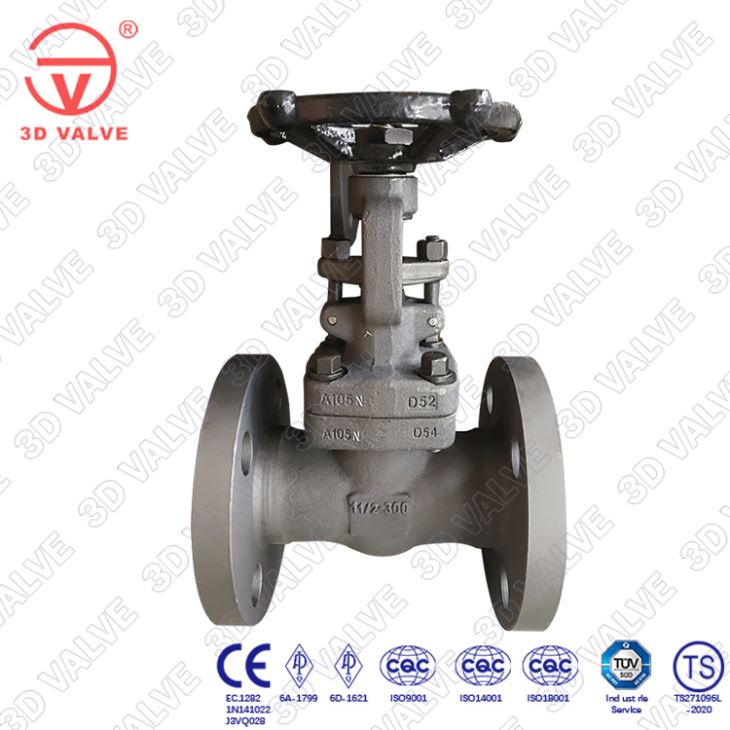

RF end forged steel gate valves are ideal for high pressure steam, catalytic reformers, hydrocrackers and other tough services.
Email-us info@tawajodindustrial.jo
RF end forged steel gate valves are ideal for high pressure steam, catalytic reformers, hydrocrackers and other tough services.
● Stronger, leakproof bolted body bonnet joint ensures joint tightness with a higher bolting torque.
● Wedge guiding minimizes seat rubbing and scuffing resulting in long cycle life.
● Designed to ASME B16.34.
● Body made of superior strength forgings and optional cast steel.
● stem seal offers tight seal with little to no maintenance over long periods of time.
● Optional live-loading of packing and leak off.
● Non-rotating stem.
● Hardfaced seating faces resist erosion.
● Available with provision for seal weld.
● Other sizes and pressure classes available. Contact the company for specifications.
Design Features
-Alternate valve materials such as chrome and stainless steel alloys
-Alternate trim materials
-Bypass, drain and other auxiliary connections
-Gear, motor, and cylinder actuators available
-NACE service
-Special cleaning for applications such as oxygen or chlorine
-Other options available as specified
Rate Range: Class 150 to Class 2500
Size Range: 1/2″ to 2.5″
Materials: CF8/CF8M/CF3/CF3M/duplex stainless steel/alloy
Operation: wheel/Bevel Gear/Air Cylinder/Hydraulic Cylinder/Electric actuator
Type: Bolted bonnet/Pressure Seal
Product Range
Body material: forged steel, stainless steel, alloy steel
Nominal diameter:1/2″~2.5″(DN15~1500)
Pressure range: Class150~2500(PN10~PN420)
End connection: RF, RTJ, BW,NPT,SW
Working temperature:-29℃~+560℃
Mode of operation: Hand wheel, Electric Actuator, Pneumatic Actuator, etc.


| Brand | 3D |
| Valve Type | RF End Forged Steel Gate Valve |
| Valve Material | A105, stainless steel, special alloy, etc |
| Valve Test | 100% quantity tested before delivery |
| Valve Guarantee | 18 months from the date of dispatch ex works, or 12 months from date of commodity installation. |
| Valve Painting | Customer request |
| Valve Package | Wooden case |
| MOQ | No requirement |
| Valve Certificate | API 6D/CE/ISO9001/ISO14001 |
| Delivery Detail | Shipped in 4 or 6 weeks after payment |
| Port | SHANGHAI |
| Payment Terms | L/C,D/A,D/P,T/T |
| Certificate Offered | Packing List,Commercial Invoice,Test Reports and Material Certificates,Certificate of quality and quantity, Seller’s Certificate of Guarantee |
What is the suitable medium temperature for different body and cover materials?
The suitable medium temperatures for different body and cover materials are as follows:
The maximum service temperature of medium suitable for grey cast iron valve body and cover is 250 C.
Malleable cast iron valve body and cover are suitable for medium with a maximum service temperature of 300 C.
Ductile iron valve body and cover are suitable for medium with a maximum service temperature of 350 C.
High silicon cast iron valve body and cover are suitable for medium with a maximum service temperature of 120 C.
Carbon steel valve body and cover are suitable for medium with a maximum service temperature of 425 C (forgings 16Mn and 30Mn can reach 450 C).
Cr5Mo alloy steel valve body and cover are suitable for medium with a maximum service temperature of 550 C.
1Cr18Ni9Ti and Cr18Ni12Mo2Ti stainless steel body and cover are suitable for medium with a maximum service temperature of 600 C.
Copper alloy valve body and cover are suitable for medium with a maximum service temperature of 200 C.
Titanium body and cover are suitable for medium with a maximum service temperature of 300 C.
Plastic valve body and valve cover are suitable for medium maximum service temperature: nylon 100 C, chlorinated polyether 100 C, polyvinyl chloride 60 C, polytrifluorochloroethylene – 60 – 120 C, polytetrafluoroethylene – 180 – 150 C.
Rubber diaphragm valves depend on the type of rubber, natural rubber 60 NBR, chloroprene rubber 80 and fluororubber 150.
When using rubber and plastics for valve lining, the temperature resistance of rubber and plastics shall prevail.
Ceramic and glass valves, which have poor temperature resistance and rapid change, are generally used below 90 C.
The temperature resistance of enamel valves is limited by the sealing ring material, and the highest medium temperature is over 150 C .
